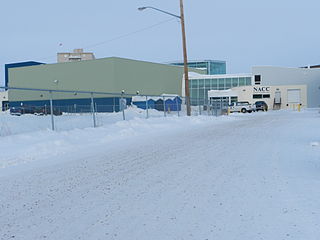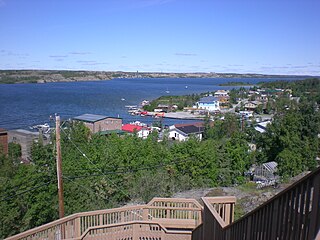The Ptarmigan and Tom Mine were gold producers located in the Northwest Territories, Canada at Yellowknife. The property was staked by prospectors in 1936 and acquired by Cominco in 1938. The mine first produced between 1941 and 1942 but closed due to wartime restrictions. The old property was demolished in 1969–1970. A new company, Treminco Resources Limited, reopened the workings in 1985 and production from the Tom portal began in 1986 with material being trucked to Giant Mine. The old Ptarmigan mine shaft was dewatered and production began in 1987. A new mill was built at the property and was operational in July 1989. Low gold prices forced the company to close the mines in 1997. Total gold production has been approximately 120,000 troy ounces.
Negus Mine was a gold producer at Yellowknife, Northwest Territories, Canada, from 1939 to 1952. It produced 255,807 troy ounces (7956 kg) of gold from 490,808 tons of ore milled. The underground workings were acquired by adjacent Con Mine in 1953 and were used for ventilation purposes until Con Mine closed in 2003.

The Burwash Mine was a small gold property discovered in the fall of 1934 by Johnny Baker and Hugh Muir at Yellowknife Bay, Northwest Territories. The town of Yellowknife did not exist yet at that point, but the discovery of gold at Burwash was the catalyst that brought more gold prospectors into the region in 1935 and 1936. A short shaft was sunk in 1935-1936 at Burwash, and in the summer of 1935 a 16-ton bulk sample of ore was shipped to Trail, British Columbia for processing, yielding 200 troy ounces of gold. The mine did not become a substantial producer and it is believed the gold vein was mined out.

The Yellowknife River is a river in the Northwest Territories, Canada. It flows south and empties into Yellowknife Bay, part of Great Slave Lake, at the city of Yellowknife. The lake is drained by the Mackenzie River into the Arctic Ocean as part of the largest drainage basin in Canada. The name of the river derives from the Yellowknives Dene, a First Nations people who have lived in the area for thousands of years.

Behchokǫ̀ ([bɛ́ht͡ʃʰókʰõ̀] or [bɛ́ht͡sʰókʰõ̀], officially the Tłı̨chǫ Community Government of Behchokǫ̀, is a community in the North Slave Region of the Northwest Territories, Canada. Behchokǫ̀ is located on the Yellowknife Highway, on the northwest tip of Great Slave Lake, approximately 110 km northwest of Yellowknife.
Fort Smith Region was a former Statistics Canada census division, one of two in the Northwest Territories, Canada. It was abolished in the 2011 census, along with the other census division of Inuvik Region, and the land area of the Northwest Territories was divided into new census divisions named Region 1, Region 2, Region 3, Region 4, Region 5, Region 6.
CIVR-FM is a Canadian radio station, broadcasting at 103.5 (MHz) FM in Yellowknife, Northwest Territories. Branded as Radio Taïga, the station airs a community radio format for Yellowknife's Franco-Ténois community.

The Yellowknife Catholic School Board is the school board responsible for École St. Joseph School, Weledeh Catholic School, École St. Patrick High School and the Kimberlite Career & Technical Centre in Yellowknife, Northwest Territories, Canada.

The Yellowknife Education District No. 1 is the public school board in Yellowknife, Northwest Territories. The district, then called Yellowknife School District No. 1, was created 1 October 1939 by Charles Camsell who was Commissioner of the Northwest Territories.
Northern News Services (NNSL) is a news company based in Yellowknife, Northwest Territories with approximately 60 employees. It is one of the few remaining independent newspapers in Canada, producing all-original content with little to no reliance on syndicated news. NNSL publishes seven different papers weekly: Kivalliq News, Inuvik Drum, Dehcho Drum, Yellowknifer, News/North.

Highway 4, known as the Ingraham Trail, extends from Yellowknife, Northwest Territories to Tibbitt Lake, approximately 70 km (43 mi) east of Yellowknife. It was built in the mid-1960s as the first leg of a 'road to resources' with the original intention of circulating Great Slave Lake.
News/North is a newspaper based in Yellowknife, Northwest Territories, with offices in Fort Smith, Hay River, Fort Providence and Norman Wells, Northwest Territories, as well as Iqaluit and Rankin Inlet, Nunavut, and owned by Northern News Services. The newspaper is printed in two separate editions, Northwest Territories News/North and Nunavut News/North that reports on news throughout the NWT and Nunavut. Although some features are identical in the two papers, the majority of the articles reflect the territory they are intended for. The Nunavut News/North features several articles translated into Inuktitut and printed in syllabics. A Monday edition is printed weekly, with a different front page substituted on the Northwest Territories News/North for distribution in Yellowknife.

The Northern Arts and Cultural Centre is located in Yellowknife, Northwest Territories, Canada. It is the only performing arts centre in the NWT.

The Prince of Wales Northern Heritage Centre (PWNHC) is the Government of the Northwest Territories' museum and archives. Located in Yellowknife, Northwest Territories, Canada, the PWNHC acquires and manages objects and archival materials that represent the cultures and history of the Northwest Territories (NWT), plays a primary role in documenting and providing information about the cultures and history of the NWT, and provides a professional museum, archives and cultural resource management services to partner organizations.
Region 6 is the name of a Statistics Canada census division, one of six in the Northwest Territories, Canada. It was introduced in the 2011 census, along with Regions 1, 2, 3, 4, and 5, resulting in the abolition of the former census divisions of Fort Smith Region and Inuvik Region. It includes the city of Yellowknife, and has the largest population by far of any of the six census divisions.

Chan Lake Territorial Park is a small territorial park in the Northwest Territories of Canada, one of six such parks on Yellowknife Highway (Hwy #3), and one of 34 parks maintained by the Northwest Territories government under the Territorial Parks Act of 1988.
Ranney Hill is a rock outcrop approximately 10 kilometers north of Yellowknife, the capital city of the Northwest Territories of Canada. At 682 ft / 208 m. high, it is one of three visible outcrops that can be seen north of the city. It is an anomaly rising from the relatively flat Canadian Shield.













